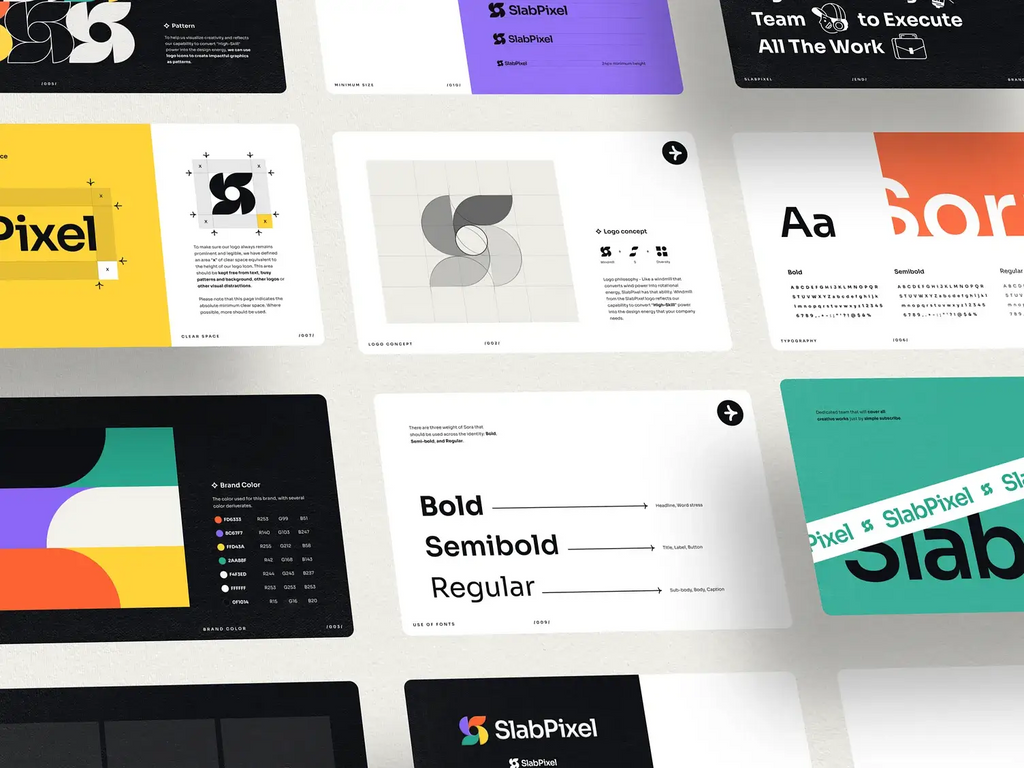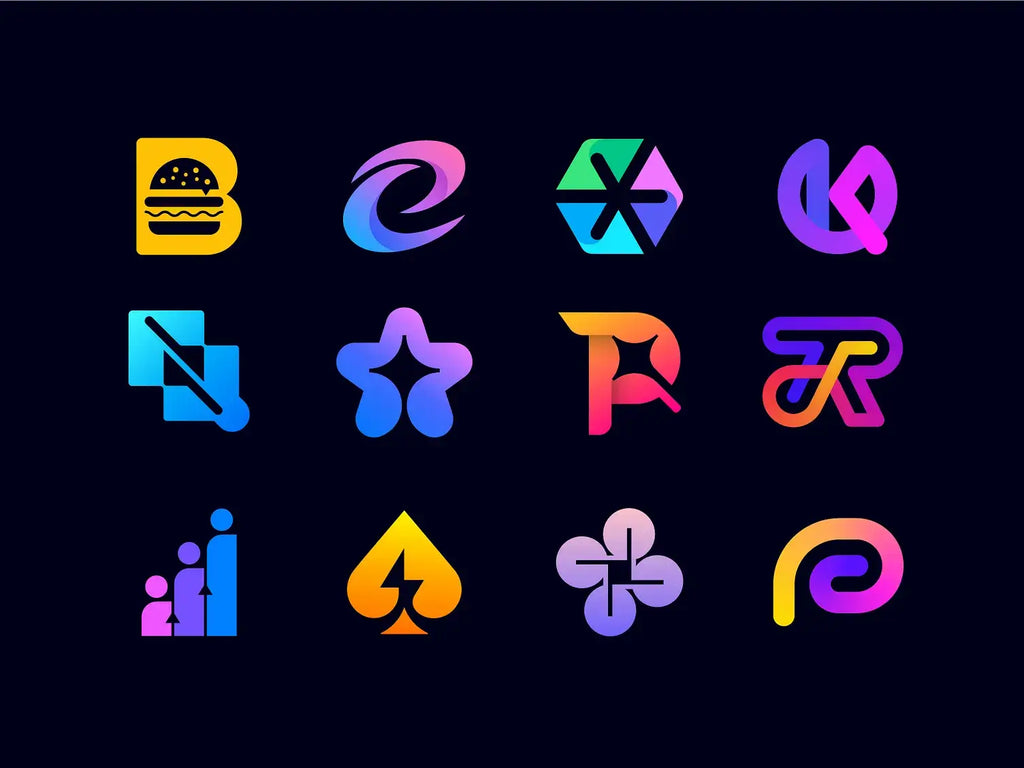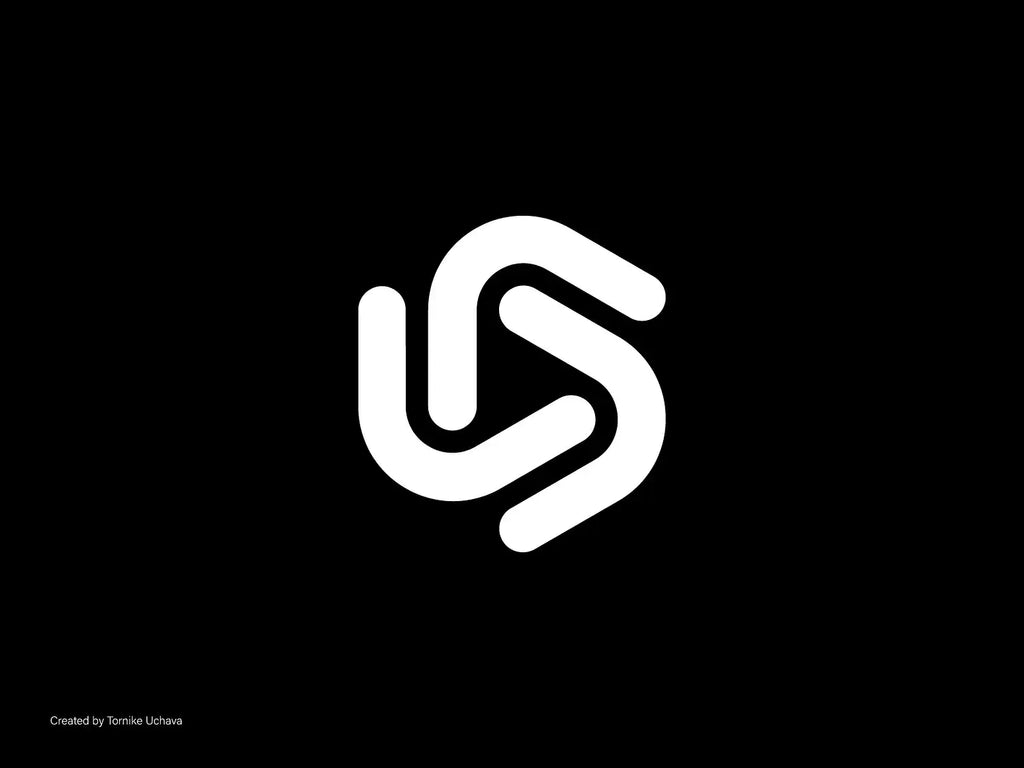Logo Variations Every Businesses Must Have

Source: SlabPixel Designer, Slab Pixel - Brand Guideline, Dribbble, https://dribbble.com/shots/18345455-SlabPixel-Brand-Guideline
The adaptability and versatility of your brand's visual identity are crucial. Logo variations play a vital role in ensuring that a business's brand is both recognizable and flexible across various mediums. Having a suite of logo variations allows businesses to maintain consistency in branding while adapting to different sizes, contexts, and applications. From digital spaces like websites and social media to traditional print media such as business cards and billboards, each platform has unique requirements. Logo variations cater to these needs by offering modified designs that retain the essence of the original logo while ensuring optimal visibility and impact.
This approach not only strengthens brand recognition but also enhances the professional appearance of a business in all its marketing and communication efforts. Thus, understanding and implementing different logo variations is not just a design task—it's a strategic business decision that can significantly influence how a brand is perceived in the competitive landscape.
Primary Logo
The primary logo is the cornerstone of a business's branding strategy. As the most visible representation of the company, it encapsulates the essence and core values of the brand in a distinctive and memorable design. This logo is typically used in high-impact areas such as the company's main website header, official communications, and primary marketing materials. It should be designed to make a strong impression while being versatile enough to work across various media. The primary logo often includes the full company name accompanied by a unique symbol or brand mark that can stand alone if needed.
It's crucial that this logo variation is crafted with scalability in mind, maintaining clarity and impact at both large and small sizes. Investing in a well-designed primary logo ensures that it communicates the business’s identity effectively, fostering recognition and trust among the target audience. This logo sets the tone for all other brand materials and should be aligned with the company’s long-term vision and strategy, making it a fundamental tool in the toolkit of logo variations for businesses.
Secondary Logo
A secondary logo acts as a supportive visual identity element that complements the primary logo. It's typically a simplified or abbreviated version that maintains key aspects of the main logo to ensure brand consistency. This variation is crucial for applications where the primary logo may be too complex or too large to be effective. For instance, the secondary logo is often used in social media profiles, app icons, and small-scale merchandise. It retains the brand's essence without the full detail or size of the primary logo, making it more adaptable and versatile for varied uses.
Designing a secondary logo involves focusing on minimalism and clarity, ensuring it is recognizable even when scaled down. It might consist of a single letter, a smaller group of letters from the business name, or a simplified icon that is still unmistakably linked to the brand. By having a secondary logo, businesses can maintain a presence in spaces that require subtlety and simplicity, enhancing overall brand exposure and flexibility in different marketing contexts.
Icon or Symbol
An icon or symbol is a critical logo variation that distills a company's brand into its simplest form. This type of logo variation is highly effective for creating a lasting visual impact with a minimalistic approach. Suitable for businesses that aim for high recall value, an icon or symbol embodies the company in a form that is easy to recognize at a glance. This simplicity is advantageous for use on platforms where space is limited or when the full logo would be too intricate, such as on mobile apps, favicons, and merchandise like pens or keychains. The design of an icon or symbol should capture the essence of the brand’s identity through abstract or figurative imagery that conveys the brand's core message or values.
Effective use of an icon or symbol can enhance brand recognition significantly, as these elements are quickly and easily associated with the business in the minds of consumers. Therefore, it's essential for businesses to develop a distinctive and versatile icon or symbol that functions across various media and resonates with their audience, further solidifying their presence in the competitive market landscape.

Source: Graphthoery, Modern Logo Design, Symbol, Icon, Logos Collection, Dribbble, https://dribbble.com/shots/24709082-Modern-logo-design-symbol-icon-Logos-Collection
Wordmark
A wordmark is a logo variation focused purely on text, specifically the name of the company, styled in a unique and recognizable way. This logo type emphasizes typography and color, making it a powerful tool for brand recognition. A wordmark is particularly effective for businesses whose names are distinctive or have brand equity. The typography chosen for a wordmark should reflect the brand’s personality, whether it’s elegant, robust, whimsical, or modern. This logo variation plays a crucial role in branding strategies because it's often used where a symbol may not convey enough about the brand, such as on corporate paperwork, official websites, and primary signage.
It’s also particularly important for new businesses that need to establish their name in the market. A well-designed wordmark can make a brand instantly recognizable and accessible to wide audiences. Additionally, because wordmarks depend solely on typography without graphic elements, they demand high creativity in font selection and design to stand out in a crowded marketplace. For these reasons, businesses invest in crafting a wordmark that not only captures attention but also cements their name in the visual memories of their audiences.
Lettermark
A lettermark is a logo variation that uses initials from the business name to create a compact and memorable identity. This type of logo is especially useful for companies with lengthy names, making it easier for customers to recall and recognize the brand. Lettermarks are crafted by taking the first letters of each word in the company's name and designing them with distinctive typography that reflects the brand's ethos. This logo style is not only timelessly elegant but also offers versatility in its application across various media, such as business cards, stationery, and digital platforms. The design of a lettermark focuses on simplicity and visual impact, where the chosen font and arrangement of letters play a crucial role in creating a strong brand presence.
Additionally, lettermarks are often used by industries that value tradition and professionalism, like law firms, financial institutions, and architectural firms. By condensing the company name into a few letters, lettermarks simplify the visual representation of the brand while maintaining a high level of sophistication and formality. It's essential for businesses to consider how their lettermark will look both in large formats and when scaled down to fit smaller spaces, ensuring clarity and effectiveness in all visual communications.
Monogram
Monograms are a refined type of logo variation where two or more letters are interwoven to create a single, cohesive symbol. This logo style is often used by businesses looking to convey a sense of luxury, tradition, or exclusivity. Monograms combine letters in a way that highlights the artistry of typography and design, making them ideal for brands in the fashion, hospitality, and luxury goods sectors. The design process involves careful consideration of how letters interact, focusing on balance, symmetry, and aesthetic appeal to ensure the monogram is pleasing to the eye. Monograms can be particularly effective for personal branding or companies with shorter names, where the interplay of letters can create a striking and memorable visual.
The intricacy of a monogram can vary from simple and clean to ornate and decorative, depending on the brand’s identity and the impression it wishes to convey. In branding, a well-designed monogram can serve as a timeless emblem that embodies the essence of the brand in a concise and stylish format. As with other logo variations, it's crucial for monograms to be scalable and adaptable to various uses, from being embossed on leather goods to being displayed on digital screens, ensuring the brand's visual identity remains consistent and powerful across all touchpoints.
Black and White Version
Every business should consider having a black and white version of their logo. This variation is crucial for applications where color printing is not an option or where a more subdued or formal appearance is required. The black and white version emphasizes the structural and conceptual strength of the logo without the influence of color, which can be particularly important in certain contexts such as legal documents, architectural plans, and some forms of advertising. This logo variation ensures maximum versatility and functionality, as it remains clear and identifiable across various media, including fax transmissions, newspaper ads, and merchandise engravings.
Designing a black and white version involves careful consideration of contrast, balance, and composition to maintain the logo's visual impact. It tests the logo's design by stripping it down to its essential form, which can reveal the design’s true quality and effectiveness. Furthermore, this variation often serves as a base model for more complex versions, proving that if a logo can stand out in black and white, it will likely excel in color as well. Businesses benefit from this approach by ensuring their brand is accessible and professional in every scenario, reinforcing brand recognition and consistency.

Source: Tornike Uchava, Minimalist Abstract Logo, Dribbble, https://dribbble.com/shots/25599651-Minimalist-Abstract-Logo-Modern-Geometric-Symbol-Design
Negative Space Logo
A negative space logo is an innovative and creative approach to logo design, utilizing the background to form an integral part of the image. This type of logo engages the audience by incorporating hidden meanings or symbols within the negative space, creating a memorable and visually engaging brand mark. Negative space logos are particularly effective for businesses that want to convey a sense of cleverness, creativity, or depth in their branding. The design of a negative space logo requires a sophisticated understanding of space, composition, and perceptual psychology, as it plays with visual elements to reveal more than meets the eye at first glance. This can make the brand stand out in a crowded market by offering a unique visual story that captivates and entertains.
Examples include logos where the space around or between elements forms a secondary, often related image, adding a layer of meaning that reinforces the brand’s message. Such logos are not only aesthetically pleasing but also functional, as they are adaptable to various uses, from large-format signage to mobile app icons. By employing a negative space logo, businesses can showcase their innovative thinking and attention to detail, traits highly valued by modern consumers. This logo variation not only enhances brand recall but also encourages deeper engagement with the audience, making it a strategic choice for businesses aiming to make a lasting impression.
Favicon
A favicon, short for "favorite icon," is a crucial logo variation for any business with an online presence. It represents the company’s brand in the smallest form and appears in the address bar, browser tabs, bookmarks, and history lists, helping users locate and identify websites more easily. Given its tiny size, usually 16x16 pixels, designing a favicon requires a focus on simplicity and clarity to ensure that the logo remains recognizable at such a reduced scale. The best favicons are those that use elements of the main logo, such as a distinctive color scheme, shape, or initial, distilled down to the essence of the brand. This miniature logo plays a significant role in enhancing the user's browsing experience by providing a visual anchor, making it easier for users to navigate between tabs and recognize the brand quickly.
Additionally, a well-designed favicon contributes to a professional and cohesive online brand identity, reinforcing the brand's presence in a subtle yet impactful way. For businesses, the favicon is not just a functional tool; it's a small but powerful brand ambassador that operates within the digital landscape, ensuring that every aspect of the brand's online presentation is polished and recognizable.
Animated Logo
Animated logos bring a dynamic edge to a business's branding strategy, capturing attention and enhancing engagement in digital environments. This logo variation uses motion graphics to add movement to a static logo, creating a memorable visual experience that can significantly increase brand recognition. Animated logos are particularly effective on digital platforms such as websites, social media, and digital advertisements, where movement can draw the viewer's eye and convey the brand's message in an interactive way. The animation might be as simple as a logo element turning or changing color, or as complex as a short story unfolding within the logo itself. The key is to keep the animation subtle and aligned with the brand’s identity, ensuring that it enhances rather than overshadows the logo’s message.
This type of logo variation not only makes the brand appear more modern and tech-savvy but also provides an opportunity for businesses to express their creativity and innovation. An animated logo can be particularly useful in video content, digital presentations, and as a loading animation, where it keeps the viewer engaged. By incorporating an animated logo, businesses can leverage the power of motion to make a strong, lasting impression in the digital world.
Conclusion
Incorporating various logo variations is essential for businesses aiming to establish a robust and flexible brand identity across multiple platforms. From primary logos to animated versions, each adaptation serves a specific purpose and enhances brand recognition in different contexts. By strategically using these variations, businesses can ensure that their brand remains adaptable, consistent, and memorable, regardless of the medium. Ultimately, a well-rounded suite of logo variations is not just a design choice but a strategic asset that can significantly contribute to the long-term success and visibility of a brand.
Let Us Know What You Think!
Every information you read here are written and curated by Kreafolk's team, carefully pieced together with our creative community in mind. Did you enjoy our contents? Leave a comment below and share your thoughts. Cheers to more creative articles and inspirations!















Leave a Comment